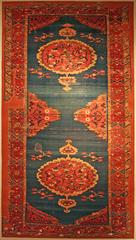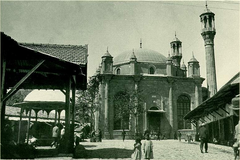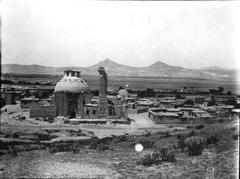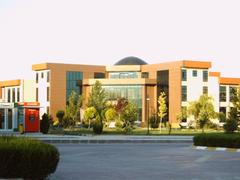İplikçi Mosque Visiting Hours, Tickets, and Comprehensive Guide to Konya’s Historical Sites
Date: 14/06/2025
Introduction
The İplikçi Mosque, located in the heart of Konya, Turkey, stands as an enduring symbol of Anatolian Seljuk architecture and spiritual life. Built in 1202 CE at the height of the Seljuk Sultanate of Rum, it is one of the region’s oldest Islamic monuments, predating many Ottoman structures and reflecting the layered history of Konya (myforevertravel.com; The Konya News). Renowned for its robust stone and brick construction, rare blue marble mihrab, and innovative acoustic fountain, the mosque is intrinsically linked to the adjacent İplikçiler bazaar—an echo of its role in Konya’s social and economic life.
The İplikçi Mosque also carries spiritual significance through its association with the Sufi poet and philosopher Jalaluddin Rumi, who is believed to have frequented the mosque during his years in Konya (Turkey Travel Planner). Today, with daily open hours and free entrance, it is an accessible and essential stop for visitors wishing to immerse themselves in both Konya’s Seljuk legacy and vibrant modern culture.
Table of Contents
- Historical Background
- Visitor Information
- Preservation and Restoration
- İplikçi Mosque’s Role in Konya’s Urban and Cultural Life
- Frequently Asked Questions (FAQ)
- Conclusion
- Visual Media
- References
Historical Background
Foundation and Seljuk Era Construction
Commissioned in 1202 CE during the Seljuk period when Konya was the capital (1075–1308), the İplikçi Mosque derives its name from the nearby İplikçiler (thread-makers) bazaar, reflecting its close integration with the economic and social life of medieval Konya (The Konya News). The mosque was initially built by the Seljuk vizier Şemseddin Altun Aba and has undergone several restorations, especially after events like the 1867 Konya Bazaar Fire (academia.edu).
Architectural Features and Innovations
İplikçi Mosque exemplifies Seljuk architectural principles:
- Materials: Primarily stone and brick, with timber roofing and spolia columns from earlier Byzantine or Roman structures (Wikipedia).
- Mihrab: The mosque features a rare blue marble mihrab—an unusual and visually striking centerpiece (The Konya News).
- Acoustic Fountain: The mosque’s renowned acoustic fountain demonstrates Seljuk mastery of sound: two individuals can converse in whispers from opposite sides of the fountain due to its unique design.
- Spatial Layout: The rectangular hypostyle prayer hall is supported by rows of columns, with large windows illuminating the interior. The mosque is built on a raised platform, its northern façade integrating eight shops that historically supported the mosque’s finances (academia.edu).
Spiritual Legacy and Notable Figures
The mosque is deeply intertwined with Konya’s religious and intellectual life. It is believed that Mevlana Jalaluddin Rumi, the famed Sufi mystic, spent time within its walls, contributing to its status as a center of worship, learning, and Sufi thought (The Konya News). The mosque’s proximity to the now-lost Altun-aba Madrasa and historic bazaar further highlights its importance.
Visitor Information
Visiting Hours and Tickets
- Hours: Open daily from 8:00 AM to 6:00 PM. Hours may vary during religious holidays or special events (Turkey Travel Planner).
- Tickets: Entrance is free for all visitors.
Accessibility and Facilities
- Accessibility: The mosque is at street level and mostly accessible, though some uneven surfaces and steps exist. Wheelchair access is generally available at the main entrance, but some areas may be challenging (kulturenvanteri.com).
- Facilities: There are no internal restrooms or gift shops, but amenities are available nearby in the city center.
Dress Code and Etiquette
- Dress Code: Modest clothing is required. Men should wear long trousers; women should cover their heads and wear long-sleeved, long-legged garments. Scarves are recommended (Triplyzer).
- Etiquette: Remove shoes before entering the prayer hall. Photography is allowed but should be discreet and never during prayers. Be respectful and maintain a quiet atmosphere.
Guided Tours and Travel Tips
- Guided Tours: Official guided tours are rarely offered at the mosque itself, but local tour operators often include İplikçi Mosque in broader itineraries of Seljuk Konya.
- Timing: Visit in the morning or late afternoon for a quieter experience and the best light for photography. Avoid visiting during Friday prayers (Jumu’ah).
- Travel Tips: Wear comfortable shoes for walking, as surrounding streets are pedestrian-friendly with cobblestones.
Nearby Attractions
- Mevlana Museum: The resting place of Rumi and a major pilgrimage site.
- Alaeddin Mosque: The principal Friday mosque of Seljuk Konya.
- Bedesten Bazaar: A vibrant market for crafts and local goods.
- Aziziye Mosque: An example of Ottoman architecture. All are within walking distance, making it easy to combine visits (Turkey Travel Planner).
Preservation and Restoration
The İplikçi Mosque has undergone significant restoration to maintain its historical integrity and structural soundness. Restoration efforts, especially after the 19th-century fire, have preserved key Seljuk features while allowing continued religious and community use (myforevertravel.com).
İplikçi Mosque’s Role in Konya’s Urban and Cultural Life
Historically, the mosque served as both a religious center and a social hub, closely linked to the guild of thread-makers. Its integration with the bazaar and the inclusion of shops in its structure exemplify the close relationship between religious and economic life in medieval Anatolia (myforevertravel.com). Today, the mosque continues to be a focal point for worship, community gatherings, and cultural tourism.
Frequently Asked Questions (FAQ)
Q: What are the visiting hours for İplikçi Mosque?
A: Daily from 8:00 AM to 6:00 PM, except during prayer times and religious holidays.
Q: Is there an entrance fee?
A: No, entrance is free for all visitors.
Q: Is the mosque accessible to wheelchair users?
A: Main entrance generally has ramps, but some areas may be less accessible due to historic structure.
Q: Are guided tours available?
A: Not officially at the mosque, but many local tour operators include it in their Konya heritage tours.
Q: Can I take photographs inside?
A: Yes, but only outside of prayer times and always respectfully. Avoid using flash and ask permission before photographing people.
Visual Media
Plan Your Visit and Stay Connected
Ready to explore the architectural and spiritual heritage of Konya? Plan your visit to İplikçi Mosque and nearby attractions for a comprehensive experience. For guided tours, up-to-date information, and curated travel content, download the Audiala app. Follow us on social media for the latest updates and expert tips to enrich your journey.
References
- Famous Mosques in Konya with Rich History, The Konya News
- Seljuk Konya, myforevertravel.com
- İplikçi Mosque, Turkey Travel Planner
- Exploring the Historic Konya İplikçi Mosque: A Window into Seljuk Architecture and Art, The Konya News
- İplikçi Mosque, Wikipedia
- İplikçi Camii, kulturenvanteri.com
- Konyadaki İplikçi Camii’nin Aslî Hali ve Ehemmiyeti, academia.edu
- Triplyzer: Things to Do in Konya
- Ways of the World Blog: Things to Do in Konya
- Visit Turkey: Konya



